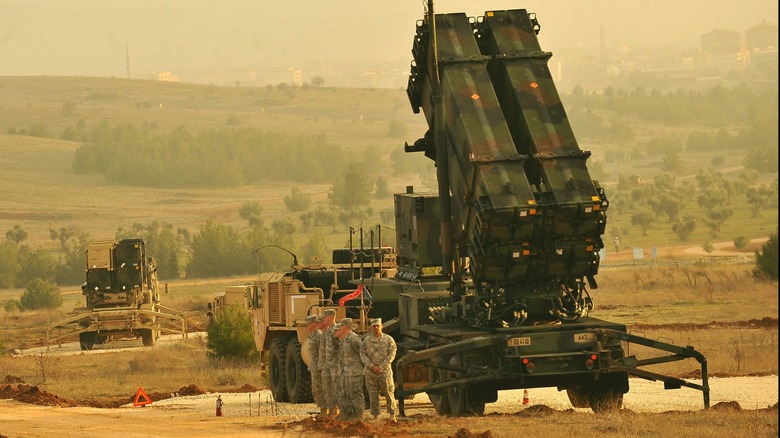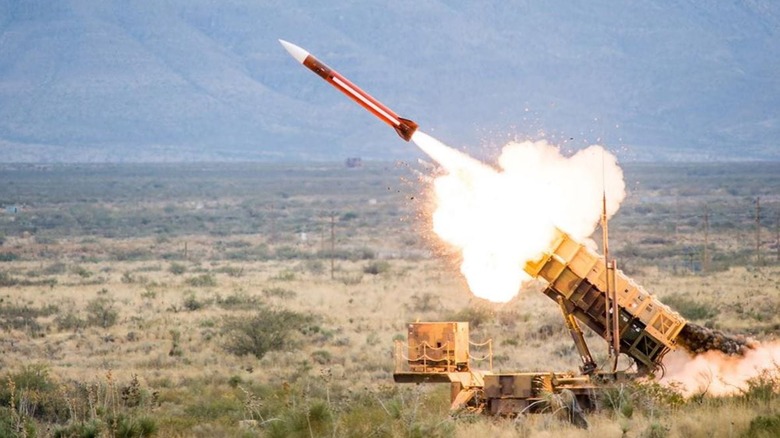How Many Patriot Missile Systems Are In The US Army's Arsenal?
Due to the ongoing conflict in the Middle East and the established need for missile defense systems, the MIM-104 Patriot has once again surged into the spotlight. The Patriot Air Defense System is a mobile surface-to-air missile launcher and interceptor designed specifically to counter airborne threats, such as inbound ballistic missiles. It is a medium-range tactical air defense system that has repeatedly demonstrated an ability to take out ballistic missiles in places like Israel, where it's heavily employed by the Israeli Defense Forces.
With an increase in talk about missile defense, following President Donald Trump's declared desire to build a "Golden Dome" around the United States, it's natural to wonder how many Patriots are in the inventory. Since the Patriot's introduction in 1981, around 1,100 have been acquired by the U.S. Army. Approximately 200 of the produced launchers have been exported to countries such as Israel, Japan, Germany, and 16 others. In addition to the launchers, over 10,000 missiles have been produced, and more are on the way.
The Patriot Air Defense System has a 95% intercept success rate with over 250 combat engagements, including the defense of Al Udeid Air Base in Qatar in June 2025. Because of its successes in defending against ballistic missiles, the Patriot Air Defense System is expected to remain in service until at least 2040, when it's believed that technology will evolve to require faster and more agile interceptors. In the meantime, the Patriot will continue to operate as the nation's primary terminal-phase anti-ballistic missile system well into the future.
The MIM-104 Patriot Air Defense System
Like most military technology the United States has employed for several decades, the Patriot Air Defense System has undergone upgrades and refits over the years. The current version is the PAC-3 Missile Segment Enhancement (MSE), developed and produced by Lockheed Martin. The missile range has been extended, and the interceptor has also been made more agile. In addition to working in the M90X Launching Stations, the PAC-3 missiles have been integrated into the THAAD Weapon System and other launchers.
Since its introduction, Lockheed has produced at least 1,700 PAC-3 MSEs and continues to build them for the U.S. Army and other clients. Each PAC-3 missile canister holds four missiles, allowing for 12 to 16 to be placed onto a launcher. The missiles are smaller in diameter, weighing 388 pounds, which is a third of the weight of previous interceptors. It also uses hit-to-kill technology, which differs from previous missiles' method of using a blast-fragmentation warhead to take out targets.
It has the ability to defend an area that is seven times that of the PAC-2. The system is more than the interceptors and their launchers, as it also employs a single AN/MPQ-53, AN/MPQ-65, or AN/MPQ-65A radar set to find potential targets. With this, the Patriot uses the AN/MSQ-4 Engagement Control Station, which is installed on an M927 truck. This is the only crewed part of the Patriot Missile Battery system; though much of the engagement is done autonomously, the crew's responsibility is the decision to launch.
Patriot Missile System's combat performance
One of the reasons Raytheon and Lockheed Martin have been pumping out Patriot missile interceptors and the required launchers is that they have a proven combat history. With 10,000 interceptors produced and more on the way, it's likely Patriots will see more combat in the future as tensions continue to ramp up. Patriots first saw action during the 1991 Gulf War, where they protected Kuwait, Israel, and Saudi Arabia from Iraqi Scud short-range ballistic missiles.
While largely successful, some warheads failed to function as desired, prompting the program to undergo additional development and improvements. Patriot Air Defense Systems have since been used in a variety of conflicts, including the Yemeni Civil War, the Russo-Ukrainian War, and throughout Israel, though it retired the system in 2024 in favor of its native-produced David's Sling system. Patriots have proven quite capable of taking down some types of ballistic missiles, though it's not capable of striking an ICBM, as they are notoriously hard to shoot down.
The largest American use of the Patriot Air Defense System came in response to an Iranian retaliatory attack against the United States in June 2025. Iran fired multiple ballistic missiles at Al Udeid Air Base in Qatar, but they were stopped by Patriot interceptors. Only two batteries and 44 soldiers, the oldest of whom was a 28-year-old captain, defended the entire base. They successfully downed seven over the Persian Gulf, another 11 over Doha, Qatar, and a single missile landed in an uninhabited area of Al Udeid Air Base.


